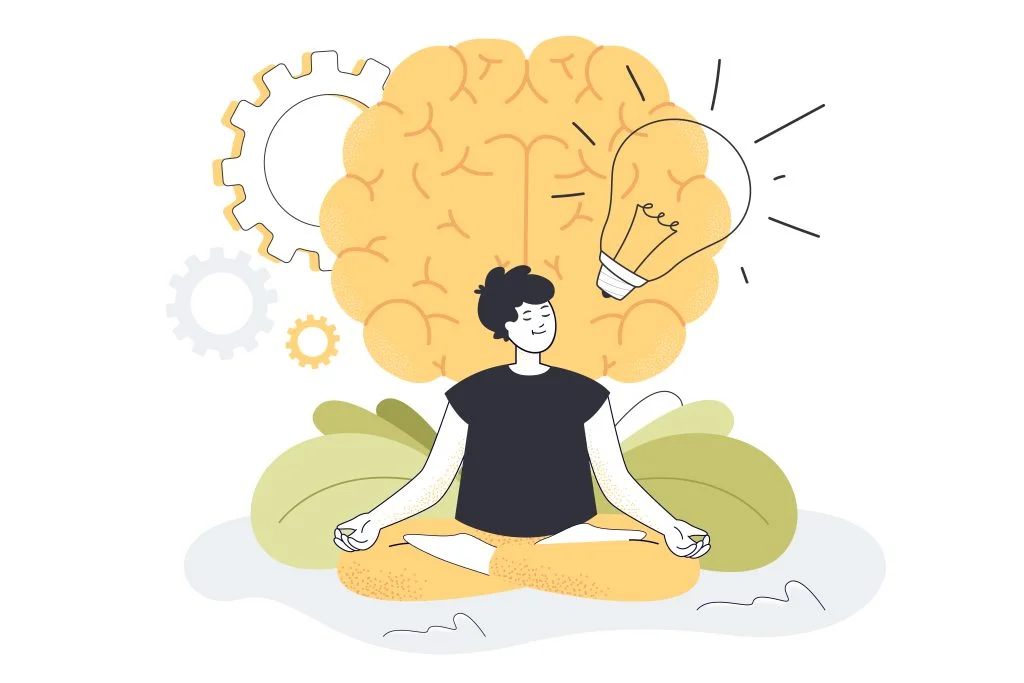It is a kind of mental training or practice that teaches you to slow down racing thoughts, let go of negativity, and calm both your mind and body. It combines meditation with the practice of mindfulness, which can be defined as a mental state that involves being fully focused on present moment.
Mindfulness Meditation is a practice like giving a break to your mind from your busy work life style and tuning into the present moment. It’s all about paying attention towards present moment, your thoughts, feelings, sensations, and what’s around you—without getting lost in worries about the past or future.

How to Practice Mindfulness Meditation:
These are the following point how to practice it:
- Take your seat. Whatever you’re sitting on—a chair, a meditation cushion, a park bench—find a spot that gives you a stable, solid seat, not perching or hanging back.
- Notice what your legs are doing. If on a cushion on the floor, cross your legs comfortably in front of you. (If you already do some kind of seated yoga posture, go ahead.) If on a chair, it’s good if the bottoms of your feet are touching the floor.
- Straighten—but don’t stiffen—your upper body. The spine has natural curvature. Let it be there. Your head and shoulders can comfortably rest on top of your vertebrae.
- Situate your upper arms parallel to your upper body. Put hands drop onto the tops of your legs. With your upper arms at your sides, your hands will land in the right spot. Too far forward will make you hunch. Too far back will make you stiff. You’re tuning the strings of your body—not too tight and not too loose.
- Drop your chin a little and let your gaze fall gently downward. You may let your eyelids lower. If you want to open your eyes half open yo can , but it’s not necessary to close your eyes when doing meditating. You can simply let what appears before your eyes be there without focusing on it.
- Be there for a few moments. Relax. Bring your attention to your breath or the sensations in your body.
- Feel your breath—or some say “follow” it—as it goes out and as it goes in. (Some versions of this practice put more emphasis on the outbreath, and for the inbreath you simply leave a spacious pause.) Either way, draw your attention to the physical sensation of breathing: the air moving through your nose or mouth, the rising and falling of your belly, or your chest. Choose your focal point, and with each breath, you can mentally note “breathing in” and “breathing out.”
- Inevitably, your attention will leave the breath and wander to other places. Don’t worry. There’s no need to block or eliminate thinking. When you get around to noticing your mind wandering—in a few seconds, a minute, five minutes—just gently return your attention to the breath.
- Practice pausing before making any physical adjustments, such as moving your body or scratching an itch. With intention, shift at a moment you choose, allowing space between what you experience and what you choose to do.
- You may find your mind wandering constantly—that’s normal, too. Instead of wrestling with or engaging with those thoughts as much, practice observing without needing to react. Just sit and pay attention. As hard as it is to maintain, that’s all there is. Come back over and over again without judgment or expectation.
- When you’re ready, gently lift your gaze (if your eyes are closed, open them). Take a moment and notice any sounds in the environment. Notice how your body feels right now. Notice your thoughts and emotions. Pausing for a moment, decide how you’d like to continue on with your day.
Benefits of Mindfulness Meditation?
Imagine your mind is like a wild horse, always running around. Mindfulness is like the reins that help you gently steer that horse. Why it’s important:
- Stress reduce: Mindfulness Meditation helps you relax and handle stress better. Instead of panic on that things which haven’t happened yet, you will focus on present moment. This can make you feel mood happy.
- More Enjoyment: When you’re not thinking about a million things at once, you can enjoy things more. A bite of pizza, a walk outside, even talking to a friend can become richer experiences.
- Improve focus: It’s like a brain workout. When you practice it your concentration is very good on one thing at a time, which can help you paying attention better while doing anything anywhere.
- Understanding Yourself: Mindfulness lets you get to know yourself better. You start noticing why you react in certain ways, what makes you happy or upset, and that helps you make better choices.
- Improved Relationships: When you’re truly present with someone, it shows that you care. it will make your relationships more stronger by helping you listen and connect better.
- Less Reactive: Instead of immediately reacting to situations, mindfulness gives you a moment to choose how you want to respond. You will become more clam and you will become less reactive for unnecessary arguments or mistakes.
- Better Sleep: A calmer mind before bed can lead to better sleep. Mindfulness can help quiet the racing thoughts that often keep you awake.